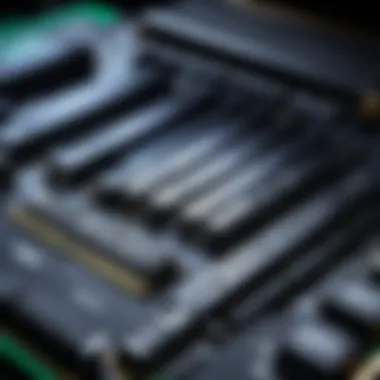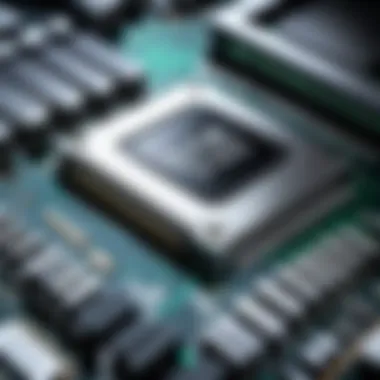Unlocking Peak Performance: Guide to Choosing the Right RAM Upgrade


The quest for the ideal RAM upgrade tailored specifically to your requirements is a crucial aspect of enhancing your system's performance. Diving deep into the intricacies of RAM types, sizes, and compatibility factors, this comprehensive guide aims to shed light on the key considerations that play a pivotal role in optimizing your system's efficiency.
Understanding RAM Basics
In this section, we delve into the fundamental aspects of RAM that are crucial for anyone considering a RAM upgrade for their system. Understanding RAM basics is the cornerstone of making an informed decision when it comes to enhancing your computer's performance. RAM, or Random Access Memory, is a volatile memory component in a computer that stores data temporarily for quick access by the processor. Without sufficient RAM, a computer may experience slowdowns and decreased multitasking efficiency. By grasping the nuances of RAM basics, such as its role in data processing and system performance, readers can streamline their upgrade journey. Unveiling the intricacies of RAM types, sizes, and compatibility factors sets the stage for an insightful exploration into determining the optimal RAM upgrade for diverse needs.
What is RAM?
When pondering the question, 'What is RAM?' we encounter a fundamental component of a computer's architecture. RAM serves as a storage medium that allows the processor to access data and instructions swiftly. Unlike permanent storage devices like hard drives, RAM's data is volatile, meaning it is lost when the computer shuts down. The capacity and speed of RAM impact system performance significantly, influencing tasks such as application loading times, multitasking capabilities, and overall responsiveness. Understanding the essence of RAM elucidates its critical function in enabling efficient computing and highlights its pivotal role in supporting diverse user requirements.
Function of RAM in a Computer
The function of RAM in a computer is akin to a temporary workspace where data and instructions are readily available for processing. When a program is launched, relevant data is loaded into RAM to expedite its execution by the CPU. RAM's rapid read and write speeds facilitate seamless data access, essential for running applications and operating system functions smoothly. Additionally, RAM acts as a bridge between the processor and permanent storage, ensuring quick retrieval of data for ongoing operations. Recognizing the pivotal role of RAM in real-time data access, data manipulation, and system responsiveness underscores its significance in optimizing computational performance.
Assessing Your Current RAM Configuration
Checking Installed RAM
When embarking on the journey of assessing your RAM configuration, the first port of call is Checking Installed RAM. By scrutinizing the RAM modules currently integrated into your system, you gain valuable insights into the existing capacity and configuration. Check the number of RAM sticks installed, their individual capacities, and whether they are functioning optimally. This assessment aids in gauging the current performance levels and determining the scope for additional RAM upgrades. It also provides clarity on the maximum capacity your system can support and the potential room for expansion.
Determining Available Slots for Upgrading


Following the examination of installed RAM, the next crucial phase involves Determining Available Slots for Upgrading. Identifying the number of empty RAM slots on your motherboard is essential for planning the upgrade effectively. Determine how many slots are currently vacant and ready for new RAM modules. This step is instrumental in understanding the maximum RAM capacity your system can accommodate and the configuration options available for optimization. By assessing the available slots for upgrading, you can strategize the most efficient way to enhance your system's performance and elevate your overall computing experience.
Identifying Your Upgrade Needs
When delving into the realm of upgrading RAM, one of the pivotal steps is identifying your specific upgrade requirements. This section plays a crucial role in ensuring that the chosen RAM upgrade aligns perfectly with your system's needs and goals. By meticulously analyzing and defining your upgrade needs, you pave the way for a seamless and effective enhancement of your system's performance.
Determining the Purpose of the Upgrade
In the quest for the ideal RAM upgrade, determining the purpose behind this endeavor holds utmost significance. Whether you aim to enhance your system's multitasking capabilities, boost gaming performance, or streamline resource-intensive tasks, understanding the core objective of the upgrade sets the foundation for the entire decision-making process. This step acts as a guiding light, steering you towards selecting the most suitable RAM configuration that fulfills your specific requirements.
Analyzing Usage Patterns
Analyzing your usage patterns is a critical aspect of the RAM upgrade journey. By scrutinizing how you utilize your system on a day-to-day basis, you gain valuable insights into the type and amount of RAM needed to optimize performance. Whether you are a fervent gamer, a creative professional handling resource-heavy applications, or a multitasker with numerous programs running simultaneously, comprehending your usage patterns is key to tailoring the RAM upgrade to seamlessly align with your operational demands.
Assessing Performance Requirements
Assessing the performance requirements of your system forms the bedrock of making an informed decision regarding the RAM upgrade. By evaluating factors such as processing speed, multitasking efficiency, and overall system responsiveness, you can pinpoint the precise performance enhancements needed. This thorough assessment ensures that the selected RAM upgrade not only meets but exceeds your performance expectations, resulting in a noticeable and gratifying boost in your system's overall capabilities.
Understanding RAM Specifications
In this section, we will delve into the crucial aspect of Understanding RAM Specifications. To grasp the optimal RAM upgrade for your system, it is imperative to have a solid foundation in RAM specifications. By comprehending the intricate details of RAM types, sizes, and speeds, you equip yourself with the knowledge necessary to make an informed decision tailored to your needs. Understanding RAM Specifications will serve as the cornerstone in your quest for enhancing system performance efficiently. It allows you to navigate through the myriad of options available in the market and pinpoint the exact specifications that align with your usage requirements. Moreover, being versed in RAM specifications empowers you to future-proof your system and optimize its performance for an extended period. With a clear understanding of RAM specifications, you can ensure a seamless upgrade process that maximizes the benefits for your specific needs.


RAM Type (DDR3, DDR4, etc.)
When considering RAM upgrades, the type of RAM plays a pivotal role in determining compatibility and performance. DDR3 and DDR4 are among the prevalent RAM types in the market, each offering distinct advantages depending on your system requirements. DDR3, known for its affordability and widespread availability, caters well to basic computing needs and older systems. On the other hand, DDR4, with its improved speed and efficiency, is more suitable for demanding tasks like gaming and multimedia editing. Understanding the differences between these RAM types is crucial in selecting the most appropriate upgrade for your system. By evaluating your usage patterns and performance demands, you can strategically choose between DDR3 and DDR4 to optimize your system's functionality and responsiveness.
RAM Size (GB)
The RAM size, measured in gigabytes (GB), directly influences your system's multitasking capabilities and overall performance. When determining the right RAM size for your system upgrade, it is essential to consider your usage requirements and the applications you frequently use. For casual users, 8GB of RAM may suffice for basic tasks like web browsing and document editing. However, for gaming enthusiasts or professionals dealing with resource-intensive software, opting for 16GB or even 32GB of RAM enhances multitasking efficiency and ensures smooth operation. Assessing your current usage and future needs is key to determining the optimal RAM size that maximizes system performance without overcommitting to unnecessary capacity.
RAM Speed (MHz)
RAM speed, measured in Megahertz (MHz), dictates how quickly data can be accessed and transferred within the system. Higher RAM speeds result in quicker data processing, leading to improved system responsiveness and smoother multitasking. When selecting a RAM upgrade based on speed, it is crucial to align the RAM's MHz rating with your usage demands. For users engaging in graphic design, video editing, or gaming activities, opting for RAM modules with higher MHz enhances the overall user experience and minimizes latency issues. Understanding the correlation between RAM speed and system performance is vital in choosing the right upgrade that optimizes task execution and boosts productivity. Assessing the benefits of varying RAM speeds in relation to your specific usage scenarios allows you to make a well-informed decision for an efficient system upgrade.
Compatibility and Installation
RAM compatibility and installation play a pivotal role in optimizing system performance through the upgrade process. It is crucial to ensure that the new RAM module aligns perfectly with the existing hardware configuration. By focusing on compatibility, users can avoid potential issues such as system crashes, instability, or performance bottlenecks. This article delves deep into the intricate aspects of ensuring seamless compatibility and smooth installation, guiding readers towards a successful RAM upgrade experience.
Ensuring Compatibility with Motherboard
When embarking on a RAM upgrade journey, verifying compatibility with the motherboard stands out as a critical checkpoint. The motherboard serves as the central hub connecting all components within the system, including the RAM modules. Before purchasing a new RAM stick, users must cross-reference the motherboard specifications to identify supported RAM types, sizes, and speeds. This meticulous verification process minimizes the risk of incompatibility issues and ensures that the new RAM seamlessly integrates with the motherboard infrastructure. Paying attention to nuances such as DDR3 or DDR4 compatibility, maximum capacity support, and dual-channel configurations, empowers users to make informed decisions and execute a hassle-free installation process.
Steps for Installing RAM


The installation process for RAM upgrades demands precision and care to guarantee optimal performance post-upgrade. Initiating the installation procedure involves shutting down the computer, unplugging all cables, and discharging any residual power. Users should locate and access the RAM slots on the motherboard, following the specific guidelines outlined in the motherboard manual. Gently inserting the new RAM module at the correct orientation and applying equal pressure until it clicks into place signifies successful installation. Verifying the secure fit and rebooting the system allows users to confirm that the new RAM is detected and operational. These systematic steps for installing RAM emphasize attention to detail and meticulous execution, ensuring a seamless transition to enhanced system performance.
Choosing the Right RAM Upgrade
Choosing the right RAM upgrade is a pivotal aspect when optimizing system performance. In the realm of technology advancements, selecting the ideal RAM for your needs ensures seamless multitasking capabilities, enhanced processing speeds, and overall system efficiency. It is imperative to carefully evaluate various factors such as RAM type, size, and speed to align with your usage requirements and budget constraints.
Matching RAM to Usage Needs
Incorporating RAM that caters to your usage patterns is fundamental in optimizing system performance. Understanding the demands of your tasks, whether gaming, content creation, or professional applications, enables you to select the appropriate RAM size and speed. Matching your RAM to usage needs directly impacts the fluidity and responsiveness of your system, guaranteeing a smooth user experience.
Considering Budget Constraints
When contemplating a RAM upgrade, considering budget constraints is a substantial factor. Balancing performance improvements with cost efficiency is crucial in making an informed decision. Analyzing available options within your budget range and maximizing the value of the upgrade ensures a cost-effective yet beneficial enhancement to your system's capabilities.
Future-Proofing Your System
Future-proofing your system through RAM upgrades involves anticipating future performance requirements. Opting for RAM that accommodates potential system advancements and technological developments ensures longevity and adaptability. By investing in a RAM upgrade that aligns with future needs, you safeguard your system against obsolescence and maintain a competitive edge in the evolving technology landscape.
Consulting with Experts
In the realm of upgrading your RAM for optimal system performance, the significance of consulting with experts cannot be overstated. This pivotal step ensures that your investment in a RAM upgrade aligns flawlessly with your specific needs and enhances your overall computing experience. Consulting with experts provides a wealth of benefits, ranging from expert guidance on selecting the right RAM specifications to valuable insights on compatibility with your existing hardware setup. As technology evolves rapidly, seeking professional advice becomes increasingly vital to make informed decisions that maximize the longevity and efficiency of your system.
Consulting with experts offers a crucial avenue for delving into intricate details and nuances that the average user may overlook. Professionals in the field can provide tailored recommendations based on your usage requirements, helping you navigate through the myriad options available in the market. Whether you are a hardcore gamer looking to boost your system for seamless gameplay or a content creator seeking enhanced multitasking capabilities, the advice gleaned from experts plays a pivotal role in shaping your upgrade decisions.
Seeking Professional Advice
As you embark on the journey to elevate your system's performance through a RAM upgrade, seeking professional advice stands out as a judicious move. Professional advice serves as a cornerstone in mapping out the most suitable RAM enhancement strategy based on your unique needs. Engaging with experts in the field empowers you to gain insights into industry trends, cutting-edge technologies, and cost-effective solutions tailored to optimize your system's performance.
Professional advice extends beyond mere technical specifications; it encompasses a holistic approach towards understanding your current setup, future aspirations, and budget constraints. By consulting with professionals well-versed in the intricacies of RAM upgrades, you leverage their expertise to make informed choices that align perfectly with your computing ambitions. As the digital landscape continues to evolve, seeking professional advice acts as a compass, directing you towards the most efficient and effective RAM upgrade solutions tailored to your precise requirements.



